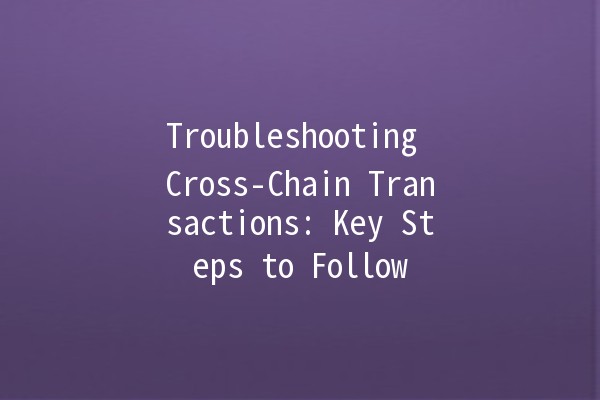




Crosschain transactions have emerged as a significant trend in the blockchain space, allowing for the seamless movement of assets and data between different blockchain networks. However, these transactions can also encounter issues that may hinder their successful completion. This article delves into the troubleshooting steps for crosschain transactions, providing practical advice and techniques to enhance productivity and resolve common issues.
Crosschain transactions refer to the process of exchanging assets or data across different blockchain networks. This innovation is pivotal for creating interoperability between various systems, enabling users to interact with multiple blockchains without needing a centralized exchange.

While crosschain compatibility can significantly enhance efficiency and flexibility, it is essential to understand potential issues that may arise. Below are key troubleshooting steps and productivityenhancing techniques to manage these challenges effectively.
High traffic on one or both chains may cause delays or failures in transaction processing. Users should always confirm that both respective networks are functioning optimally.
Incorrectly coded smart contracts may lead to failed transactions. Ensuring rigorous testing and audits of smart contracts can help mitigate these risks.
Errors in the setup of crosschain protocols can obstruct transactions. Always verify configuration settings against the protocol specifications.
Transactions must include adequate gas fees on a blockchain like Ethereum. Failing to do so can result in failure to process the transaction.
Sending to the wrong address can result in lost assets. Confirm that wallet addresses for both chains are accurate before initiating any transfer.
Description:
Regularly check the network status of both blockchains to identify potential congestion and malfunctions.
Example of Application:
Utilize tools like Block Explorer or the official status page of the relevant blockchain to track realtime performance and get alerts on operational issues.
Description:
Audit the code of smart contracts thoroughly before deployment to ensure they function as intended.
Example of Application:
Employ thirdparty security firms specializing in blockchain audits to conduct thorough checks on all smart contracts involved in crosschain transactions, thereby minimizing the risk of failures.
Description:
Carefully configure the settings of the crosschain communication protocols to reflect the intended operations accurately.
Example of Application:
Utilize documentation and guides provided by the protocol developers to verify that settings align with expected operational specifications, thereby reducing errors during transactions.
Description:
Calculate the appropriate gas fees based on network conditions and adjust as necessary for timely transaction processing.
Example of Application:
Using tools such as Gas Tracker allows users to predict gas prices while adjusting transaction fees accordingly to ensure they are sufficient to facilitate quick processing.
Description:
Doublecheck all wallet addresses before initiating crosschain transactions to prevent mistakes that can lead to asset loss.
Example of Application:
Use QR codes for addresses to prevent typographical errors and confirm that the correct address displays in the wallet interface before transferring assets.
Description:
Implement multisignature wallets to enhance asset security during transactions.
Example of Application:
In partnership with other stakeholders, use wallets requiring multiple signatures to approve transactions, providing an extra layer of security against unauthorized access.
Description:
Stay informed about updates and improvements across both blockchain networks involved in crosschain transactions.
Example of Application:
Follow developer updates, participate in community forums, and subscribe to relevant newsletters to remain aware of changes that might affect transaction protocols and stability.
Description:
Consider utilizing established crosschain solutions that provide enhanced support for facilitating transactions.
Example of Application:
Platforms like Polkadot or Cosmos offer projects designed specifically for crosschain interoperability, easing the transaction process between disparate networks.
Description:
Set up logging mechanisms to monitor transactions and identify issues proactively.
Example of Application:
Utilizing monitoring tools that log all attempted crosschain transactions allows users to analyze failures and successful transactions, thus enabling more efficient resolution of potential issues.
Description:
Tap into community forums and resources to share experiences and solutions regarding crosschain transactions.
Example of Application:
Participate in community discussions on platforms like Reddit, Telegram, or GitHub, where users share insights on common issues and troubleshooting experiences, fostering a collaborative problemsolving environment.
Crosschain transactions may fail due to various reasons, including network congestion, incorrect smart contract functioning, improper protocol configurations, and insufficient gas fees. Checking each variable can help diagnose the cause of failure.
To ensure the security of crosschain transactions, utilize multisignature wallets, conduct thorough audits of smart contracts, and stay updated with relevant blockchain improvements and security practices.
Using tools like Block Explorer, gas trackers, and official blockchain status pages can help users monitor the health of the networks involved in crosschain transactions effectively.
Gas fees can be calculated based on current network conditions, typically via gas tracking tools that reflect realtime gas prices. Be sure to adjust fees according to network traffic and transaction urgency.
If assets are sent to the wrong address, there is generally no way to retrieve them unless the receiving wallet can be accessed. Always doublecheck wallet addresses before initiating transactions to avoid this situation.
To troubleshoot smart contract errors, consider conducting audits, testing with various configurations, employing debugging tools, and consulting with community experts for targeted advice.
Crosschain transactions present unique opportunities and challenges within the blockchain ecosystem. By understanding the common issues and employing effective troubleshooting techniques, users can improve their interactions across different blockchain networks. Keeping informed and utilizing best practices will not only streamline crosschain processes but also contribute to the evolving landscape of blockchain technology.